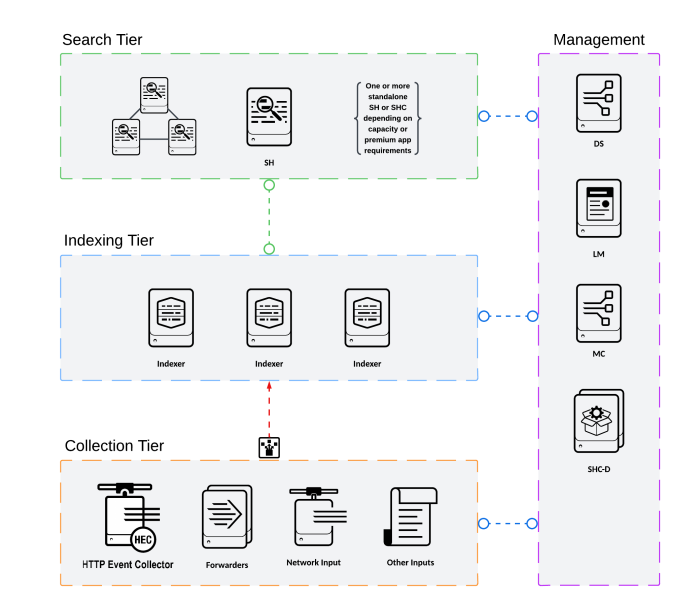Distributed Non-Clustered Deployment (D1 / D11)
The following diagram represents a distributed non-clustered deployment topology:
Architecture overview
The Distributed Non-Clustered Deployment topology introduces multiple, independent indexers using which you can scale your indexing capacity and increase availability of data ingestion.
The topology is suitable in one of the following situations:
- Your daily data volume exceeds the capacity of a single-server deployment.
- You require scalable and highly available data ingestion.
Using the monitoring console (MC), you can monitor the health and capacity of your distributed deployment. Additionally, you are notified of unhealthy conditions in your deployment by a centralized alerting system that the MC provides.
Benefits
The benefits of this topology include the following possibilities:
- To scale to more than 1000 indexer nodes to support extremely high data ingestion and search volumes.
- To maintain search performance across large datasets by executing parallel search across many indexers (MapReduce).
- To predict increase in total cost of ownership (TCO) as it grows linearly when you add indexer nodes.
Limitations
The limitations of this topology include the following:
- No high availability for the search tier
- Limited high availability and data redundancy for the indexing tier
- If a node fails, possibility of getting incomplete search results for historic searches. No impact on data ingestion.
- Necessity to explicitly configure the search head(s) with the list of available search peers, every time new indexers are added.
- Necessity to configure the collection tier with the list of target indexers via a deployment server, every time new indexers are added.
Additional considerations
When using the topology, you may find the following information helpful:
- To meet specific requirements, for example, to run some of Splunk premium apps that require dedicated search environments, deploy one or more independent search heads (SH) or search head clusters (SHCs).
- To learn about clustered architectures available in the C and M series of Splunk Validated Architectures (SVAs), see other articles in this chapter.
| Distributed Clustered Deployment - Single Site (C1 / C11) | Distributed Clustered Deployment with SHC - Single Site (C3 / C13) |
This documentation applies to the following versions of Splunk® Validated Architectures: current

 Download manual
Download manual
Feedback submitted, thanks!